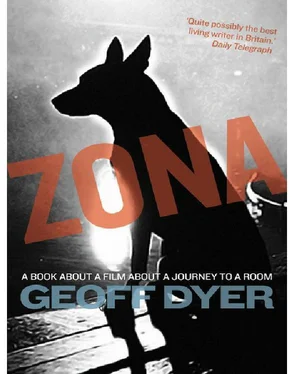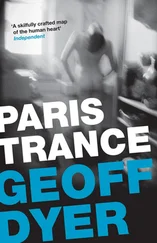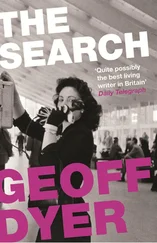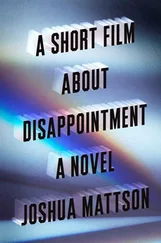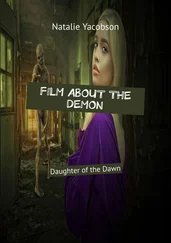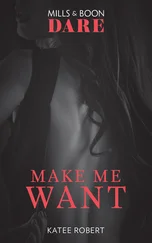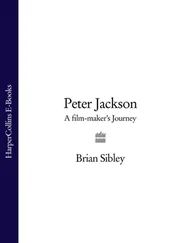The motorcyclist is a guard, patrolling a perimeter or a premise. He’s wearing leathers and a white helmet and looks like a guard from Metropolis or 1984 . Inevitably, now that certain seminal dates in the calendar of sci-fi projection—1984, 2001—have come and gone, faded into history, large parts of the genre have acquired an antiquarian quality, have become a future-oriented subset of costume drama. One possible interpretation of this sequence, then, is that Stalker and his mates are trying to escape from the clutches of history itself, from the ruinous vision of the future announced by Marx, which, a little more than a decade after the film was made, would finally declare itself obsolete and bankrupt.
There follows a cat-and-mouse car chase through what looks like an incomplete Artangel project in an abandoned warehouse from back in the days when I first saw Stalker, when there were abandoned warehouses all over London. I say car chase but there’s only one car — a car that is actually a jeep — and it’s a bit confusing in terms of where exactly Stalker is going or trying to reach. In other words it’s a car chase in classic mode in that it exists not in order to achieve anything in particular but in order to bring into existence and be part of the vehicular ritual called a car chase. While the jeep nips in and out of all this postindustrial dejection the gates are opened for the freight train whose lonesome whistle we have heard blowing. Like Luger the barman, the guy who opens the gate is smoking a cigarette. He might be Stalker’s inside man, a believer in the Zone who, for some kind of cut, has agreed to help them get through. Once the gates are open and the jeep has slithered through he runs off, to alert the authorities, presumably, so that, along with everything else, Stalker has the possibility of a double-cross to bear. We really could be in a heist movie — a sci-fi heist movie.
The big ole freight train hoves into view, bearing components of an electricity generator or something of that ilk, something huge, state-funded and probably harmful to the environment. The heavy train rumbles to the heavily guarded border crossing. The screen creaks under the weight of everything that is being projected onto it, especially since what is being projected is like a distant memory of the dawn of cinema, of the Lumière brothers and their train arriving at the station in 1895. Bright lights. The guards — dressed like the one we saw earlier on the motorbike — check to see that there aren’t stowaways hidden on or under the train. Stalker has always invited allegorical readings, and since the film has something of the quality of a prophecy, these readings are not confined to events that had occurred by the time the film was made. As the guards scan the train for stowaways, viewers of a particular political bent might be tempted to regard this train as a precursor of the Eurostar, poised to enter the Channel Tunnel, having passed close to Sangatte refugee camp, with the Zone an idealized image of the UK and its generous welfare system: a land of milk and honey with many opportunities for those willing to live in Peterborough and dig vegetables for six quid an hour. According to this reading Stalker is himself an asylum seeker — except he’s seeking asylum from the world. The irony, as Chris Marker points out in One Day in the Life of Andrei Arsenevich, his homage to Tarkovsky, is that asylum and freedom lie behind the barbed wire, in the Zone. In a way this is also true of Tarkovsky himself, for while he often felt frustrated by the control exercised by the state over his and others’ artistic freedom, in the West a subtler kind of censorship and tyranny — that of the market — would have made it extremely unlikely that he could ever have obtained permission (raised the funds) to make Mirror or Stalker . (How we loved making this point back in the 1980s!)
There’s a brief pause as Stalker waits for the right moment to make their bid for barbed-wire freedom. Writer takes advantage of this lull to get all maudlin. He doesn’t really care about inspiration, and doesn’t know what he wants or if he really wants what he wants or doesn’t want what he really wants, and he doesn’t even care if the other two are listening — and who could blame them if they’re not?
As the train makes its way beyond the barriers the jeep comes sliding along in its wake, on the coattails of the iron horse. The guards are hardly on the ball but, once the alarm is sounded and the searchlights flick on, they are not slow to open fire. It really is all action at this point — maybe Tarkovsky was right about starting slowly so people who’d come in by mistake had time to leave. There are ricochets and everything. Things get blown apart and the jeep crashes through a pile of crates. They come to a halt in another part of what seems an infinite warehouse complex, though the part they’re in seems not unlike the part they were in a few minutes earlier. The air is full of the cawing of birds. Instead of the lonesome whistle, there is the busy moan of foghorns. Whatever else it may be this is obviously a major transportation hub. Stalker tells Writer to see if there’s a trolley. In a few minutes we will see that he means a little diesel-powered thing that takes them along a narrowgauge railway track but at this point the word suggests that they are in one of the world’s more decrepit airports or an outpost of Sainsbury’s that has long since gone belly-up. Obediently, if rather grudgingly (later it will be all grudge and very little obedience), Writer goes looking for a trolley but finds only a volley — of fire from the guards. He is sent sprawling into a spongy safety net of botany. By this point he is possibly regretting all those drinks he downed before setting out on what is proving to be a quite dangerous escapade, not the well-oiled caper that he had envisaged. The sober Professor says he’ll go instead, into another even wetter and more ruined part of wherever-the-fuck they are. Shots are fired at him too but they miss and land in the water, leaving pale oblongs of light — reflections of windows, the world outside — to sway and settle and eventually, after the camera has moved on, to resume their shapely place in the brackish water’s scheme of things. Professor finds the trolley car and waves the others towards him, through the water that he’s just walked through, the water that is being dripped into by more of itself. You can see why Stalker didn’t mind about that puddle outside the bar: they all have wet feet now! Another hail of bullets, but harmless, Where Eagles Dare -ish in their harmlessness. They clamber onto the trolley car, hunched and seated, and they’re off, the three of them, chugging out of sight, screen left.
THERE FOLLOWS ONE of the great sequences in the history of cinema. First there is Writer’s head in tight close-up while, in the unfocused background, some kind of landscape blurs past. The camera moves from Writer to Professor (in his bobble hat, the texture of his coat in sharp focus) to Stalker and back as they scrutinize their surroundings with concentration, perplexity, foreboding and, in the case of Writer, a suggestion of hungover befuddlement. These are the faces — the expressions — of travellers anywhere, from Columbus’s crew in search of the Americas to tourists in a taxi on their way from the airport to a city centre that they — Writer and Professor at least — have never visited before. They’re taking everything in even though they’re not sure if what they’re seeing is any different from what they’ve already seen or where they’ve just been. Frankly, they’re not entirely sure that what they’re taking in is worth taking in, a feeling we’ve all had as we make our hyperattentive way through the universally uninteresting, often desolate stretch between airport and the luxurious promise (hotel, cafés) of the city centre. Occasionally the camera permits a focused glimpse of what they are passing through — mist, a brick building, piles of discarded pipes, crates, a river (or possibly a lake) — but even then, even when we can see clearly, we are not sure what we are seeing. Outskirts, periphery, abandonedness. Buildings that are no longer what they were once intended for: sites of decayed meaning that may, as a result, have acquired a new and deeper meaning. It depends. On what? On whether we have entered the Zone yet. Difficult to say as the camera — fixed, implicitly, to the trolley — runs horizontally through this area of in-between-ness and indeterminacy. We are, as Roberto Calasso says of Kafka’s The Trial and The Castle, ‘on the threshold of a hidden world that one suspects is implicit in this world.’ The threshold is a thin line and it is also ubiquitous. Stalker must know if we are in the Zone — he, after all, has been here many times before. So what are his feelings? His expression of furrowed anxiety, of generalized unhappiness — all the world’s a prison— has not changed since the film began, when he was quarrelling with his wife, in his sweater and underwear. What we do see, quite clearly, is the patch of white on the left side of his closely cropped hair: is it the mark of a Stalker, of some kind of election? The insistent, soporific clack of the rails is gradually infused with and gives way to clangy electronic music, moving from the literal noise of mechanical operation to a dreamy rhythmic soundscape. It’s stood the test of time, this music by Eduard Artemiev with its Indianish drone of flute and stringed instrument (a Persian tar, to be precise) fed through a synth and washing over the steady — and steadily distorting — clang and clack of the rails. It still sounds far-out, has hardly dated at all. Give it a slight remix, put it through a system with some hefty subwoofers and there’d be more than a hint of Basic Channel or one of those other minimalist electronic outfits about it.
Читать дальше
